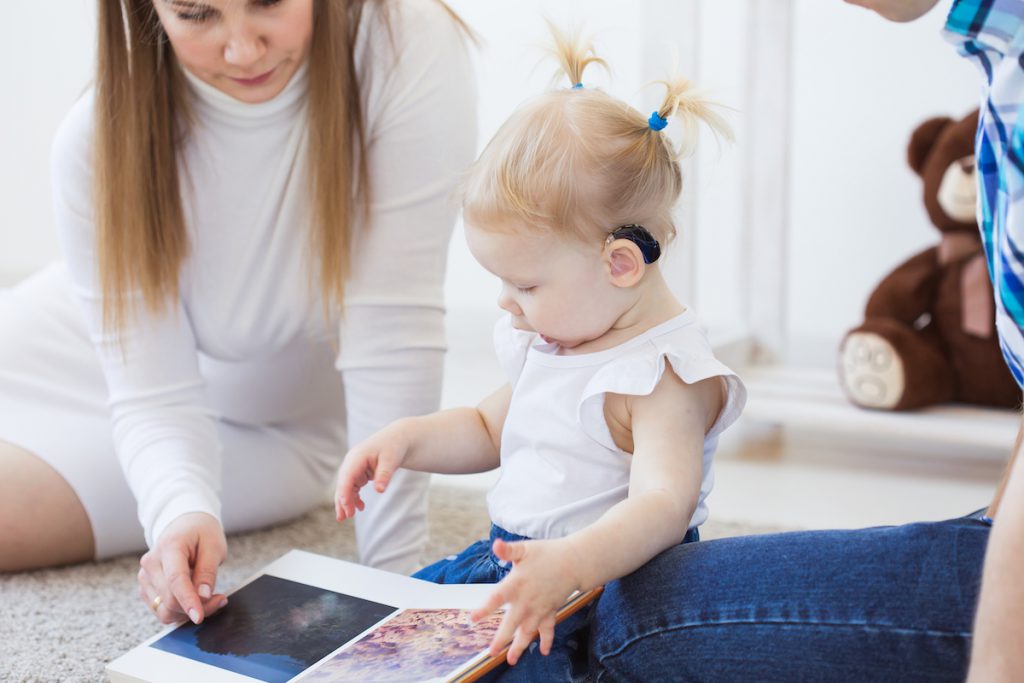Music is vital in the development of all young children, including children with hearing loss.
How do I know? I live it every day.
I’m someone with total hearing loss in one ear.
I’m a music educator who works with hearing-impaired children (at the Central Institute for the Deaf in St. Louis, MO).
And I’m a mom of a child with severe hearing loss who, with the help of bilateral cochlear implants and years of music education, has now successfully transitioned to mainstream school.
Music is one of the best ways to stimulate all areas of the brain, even in the midst of hearing difficulties.
It boosts the same developmental milestones in children who are hard of hearing as it does in every child—the difference is that some of their learning domains need heightened attention. And the earlier the better!
5 Ways Music Impacts Children with Hearing Loss
Builds Up Language and Speech
Musical activities provide a fun way for children with hearing loss to actively participate in practicing the development of their language and speech.
Things like articulation (listening then singing to build vocabulary and improve pronunciation), adjusting tone and volume of voice (like outside versus inside voices), and sequencing (determining what comes next in a song) all work together to ramp up auditory skills.

Promotes Active Listening
It’s important for children with hearing loss to be able to know and discern what sounds they are hearing.
In my Kindermusik classes, we practice active listening in three steps:
- First, I tell the children what we are going to listen to and often show a visual simultaneously.
- Next, we listen to a recording of the sound.
- Last, I prompt the children to copy the sound with their voices.
This intentional activity allows children to increase their “sound vocabulary.”

Increases Literacy and Pre-Reading Skills
In addition to articulation, sequencing, and other elements that boost language skills (all critical to reading), learning musical symbols is a natural way to promote literacy.
Symbols, like letters that produce words, have rules and are arranged in meaningful ways.
That exposure can be extremely beneficial for early readers who may have trouble with sounds, but can make letter-to-word connections in other ways.

Develops Inhibitory Control
All children need to learn to internally stop their bodies, but it’s critical for those with hearing impairments.
For example, potentially missing or experiencing delayed auditory cues, such as “STOP!” in a parking lot when a car is coming is a safety issue.
In Kindermusik, we use a lot of stop-and-go activities to practice these behaviors—stopping and starting to musical cues makes inhibitory control fun!
Strengthens the Vestibular System
Children with hearing loss often struggle with balance issues. So, it’s especially important to strengthen their vestibular system—a sensory system that provides the brain information about balance, spatial orientation, and motion.
In Kindermusik, we often pair music with cross-lateral movement (or crossing the midline) to boost this part of the body. Essentially, we’re pairing movement of one side of the body with the other, which forces the two brain hemispheres to work together and ramps up the vestibular system.
Crossing the midline looks different by age and may include crossing fingertips to toes (for babies), hands to lap (for toddlers or older children), or even rocking in a homemade hammock (a large towel with adults on each end swaying the child).
If you have a child (or teach children) with hearing loss, consider adding music to your daily routines! From building confidence to vocabulary to movement control, music is a foundation for success in all areas of their lives.
Ellen Singh is a licensed Kindermusik educator who works with the Central Institute for the Deaf in St. Louis, MO. This article was originally posted on the CID blog and was revised and republished with permission.
Search for a Kindermusik class near you for a supportive community and positive learning environment, or learn more about bringing Kindermusik to your school!

